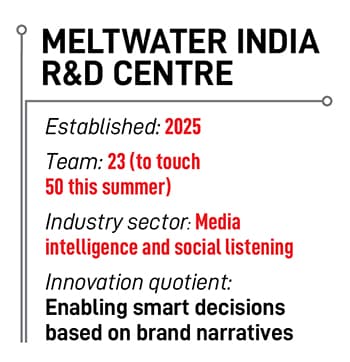
Aditya Jami, CTO, Meltwater
Image: Kris Lori / Meltwater
Meltwater’s brand-new R&D centre in Hyderabad, which opened just weeks before, as we went to print, is probably an example of a company that one wouldn’t immediately associate with the idea of setting up a GCC in India.
The company was founded in Norway in 2001 and later moved its headquarters to San Francisco. It was also listed on the Oslo Stock Exchange before being acquired by MW Investment, a private equity firm, in 2023. Having grown via multiple acquisitions—the best known is that of Linkfluence, a social listening company—Meltwater is today a specialist in helping enterprise customers understand how their brand stories are doing out there.
Aditya Jami, the company’s global CTO, the brain behind the current Meltwater platform, describes it as a “media intelligence” provider. Eight years ago, it was Jami, a computer scientist and entrepreneur who, having sold his own startup, was tasked with building the tech for this transformation of Meltwater—from a news monitoring company to a media intelligence company.
A Stanford graduate, Jami has also previously worked at Yahoo and Netflix. He was also a visiting scientist at Cornell University.
“The Hyderabad centre is not really about cost arbitrage,” Jami tells Forbes India. “So, there is a little bit of that, but it’s really about a place where we can find talent and experience.” Jami has recruited for large scale data processing, AI modelling and so on.
 The modelling work isn’t about building foundational models, he explains, but about training existing models to produce useful output within Meltwater’s products for search, research and engagement in a “multi-modal” world.
The modelling work isn’t about building foundational models, he explains, but about training existing models to produce useful output within Meltwater’s products for search, research and engagement in a “multi-modal” world.
The recruits are “people who have experience with model distillation techniques, fine-tuning of the models, making them work at scale”, he says. While Meltwater had a modest presence in India since about 2010 for its sales, and a small R&D and support presence in Bengaluru, “six months ago we didn’t have anything… we really wanted a full-scale R&D centre that works on product development and product engineering”.
And once word got out, a lot of help organically came his way and the Hyderabad centre was a “phenomenal effort”, he says. At the time of this interview, on January 22, about two weeks after Jami opened the Hyderabad R&D centre, he’d already managed to recruit more than 20 people. And he is looking for more and is keen to onboard AI engineers with experience in natural language processing, and people with expertise in image processing and computer vision in general.
This is in addition to engineers who are good at building general purpose efficient systems, and those with experience in distributed systems, large scale data and so on.
Primarily used by PR, communications and marketing executives, the Meltwater platform hooks up with “thousands of APIs” (application program interfaces) and ingests billions of documents and multi-modal pieces of content, Jami says.
Also read: We are on a transformation journey: Harman India’s Krishna Kumar G
This a rich source of data for all the AI work the company does, having grown to a “half-a-trillion document indexing cluster”, he says. And the platform supports 140 languages in 90 countries.
“Our customers can do deep research on topics on their brands to understand what the sentiment is or what the narratives are.” It’s all about getting the right campaigns and narratives in front of the right audience at the right time, and the India R&D centre will play a strong role in making Meltwater’s underlying platform and product suites on top of it future-ready, Jami hopes.
In the coming years, “we want this to be like a GCC, as in having all the functions”, he says. On the tech front, working on agentic AI is an important area, and Meltwater has already struck a deal with Microsoft to find ways of combining Meltwater’s data trove and the Microsoft Copilot ecosystem.

Thus far, generative AI has been used to boost productivity and deliver efficiency, he says.
“Now we are tapping into more of a transformation use case, and the goal is to elevate our users to focus on strategic impact.” The plan is to build AI agents that can independently execute on specific goal-oriented tasks, while a user can focus on setting a high-level goal.
And “instead of just giving you an answer, the AI tries to do some work, validate, refine, asks you when to interfere and so on, to get the final outcome.”
(This story appears in the 21 February, 2025 issue
of Forbes India. To visit our Archives, click here.)


 The modelling work isn’t about building foundational models, he explains, but about training existing models to produce useful output within Meltwater’s products for search, research and engagement in a “multi-modal” world.
The modelling work isn’t about building foundational models, he explains, but about training existing models to produce useful output within Meltwater’s products for search, research and engagement in a “multi-modal” world.